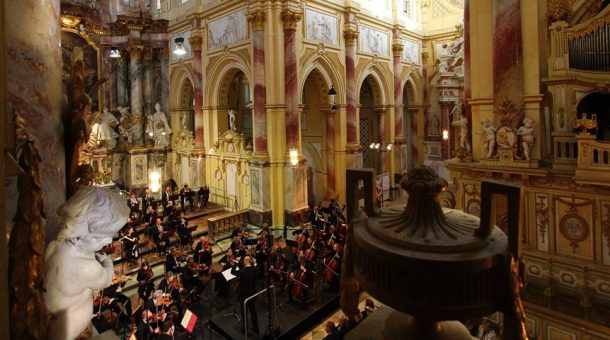 Germany Ebracher Musiksommer [1] – Gigantisch: Philharmonie Festiva / Gerd Schaller (conductor). Ebrach Abbey, Germany. 14.7.2024. (KW)
Germany Ebracher Musiksommer [1] – Gigantisch: Philharmonie Festiva / Gerd Schaller (conductor). Ebrach Abbey, Germany. 14.7.2024. (KW)

Bruckner – Symphony No.8 (1890)
At the tumultuous close of this fast and passionate performance of Bruckner’s Eighth Symphony, Maestro Schaller held his arms aloft, the moment frozen, a stunned and extended silence, and I said to myself, ‘What the blazes was that?’ – or words to that effect! It was a feeling as though one had stood upon the station platform waiting for the circuitous slow train to heaven, and suddenly, unexpectedly, a mighty express had thundered through. It was often a very loud performance, and a performance that was over in not much more than an hour and ten minutes, the first movement took just over 13 minutes, the Adagio somewhat less than 21 minutes – quicker than probably all those you can find listed on John Berky’s discography at abruckner.com.
It was such a shock partly because we were here with the orchestra in an ecclesiastical space, the vast Abbey at Ebrach, where you expect the quiet and the meditative – and a measured slowness. We know our Bruckner’s Eighth, a monumental and deeply profound work and, as Robert Simpson tells us, Bruckner teaches us patience. But right from the start, the opening theme carried a sense of urgent and anxious aspiration, each phrase shaped to surge emphatically towards its momentary destination, the following phrase impatiently carrying the energy forward. The quick tempo helped make the transition to the second theme totally seamless, and the song that this Gesangsperiode sang was not for a moment a matter of lyrical relaxation, but more one of heartfelt assertiveness and gathering momentum.
The performance of the first movement swept you up with hardly a moment to reflect on the grim and violent crises of its climaxes, the whole movement displaying a unity of purpose, an awe-inspiring grip on the long line of the musical argument. At the end, the repeated phrases of the closing ‘death watch’ were absolutely metronomic, a tempo, and no diminuendo. Suddenly it was over! After this, the Scherzo seemed to be full of joyful exuberance, the thumping timpani as exciting to watch as to hear, the stirring, climbing bass line in cellos and double basses in the crescendo (bars 11-18) in the middle of the exposition of the theme, brought to the fore. The trio was never in danger of pre-empting the slow movement proper, and if it was a dream, then it was a songful dream of triumphant vitality.
Playing the massive Adagio at a ‘flowing’ pace certainly achieved, as in the first movement, a sense of the long line and the unity of the movement. The arpeggio motive of the opening theme, at bar 15, surged upon us suddenly at an increased tempo, giving added excitement and direction, the destination ultimately to be revealed as the same motive forming the main climax. All the landmark moments of the movement were, of course, in place, but not as we are used to hearing them. The ultra-slow religioso was nowhere to be heard; it seemed more an agitated and often loud celebration of Bruckner’s glorious melodies and sounds. On the way up to the climax the allusions to the heroic Siegfried motive rang out impetuously and Schaller remained true to his interpretation even in the closing pages of the Adagio which, rather like the close of the first movement, made no concession to sentimentality, no unmarked decelerando or diminuendo, the music a tempo and sounding rather as though it were a gentle end to a serenade.
Tempo for the Finale was not so far from that adopted by many other conductors – on the quick side but not unprecedented. Even so, the movement rushed by, fraught with drama and event, the brass resplendent, the timpani dramatic. Schaller was able to ensure that the direction and coherence of the music was never in doubt, and the magnificent coda was fast and very exciting, the Scherzo theme ringing out, now gloriously triumphant, above the sonorous superimposition of the symphony’s themes. The overall effect was quite shattering.
No doubt, if you are wedded to performances of the stature of Karajan, Jochum, Giulini, Wand et al, Schaller’s take on this music will not be to your taste. And indeed, 14 years earlier, judging from his recording of the 1888 ‘variant’ of the first version, Schaller’s approach was much more expansive than it is now, that recorded performance lasting about 13 minutes longer than this present performance. But how refreshing it is to hear an interpretation of the symphony so different from that which we are used to hearing, gigantic and monumental indeed, but shorn of much of the mystical trappings, the slow and often rather heavy profundity that is presented by those other famous interpretations; instead we heard a symphony of turbulent excitement, passionate energy throughout, with a strong sense of line and of the over-arching form, celebrating the complexity and the liveliness, the coherence and the sheer glory of the sound of Bruckner’s music. And of course, the Philharmonie Festiva played wonderfully as they always do, a performance full of commitment and panache.
The edition was unspecified, and as the original manuscripts are now all available to peruse online, it is possible that the conductor made his own edition as he has for some performances of other Bruckner symphonies. However, I heard nothing to identify it as being other than the Nowak edition. The performance was recorded by BR Klassik and will be issued on CD by Hänssler Profil.
Ken Ward
